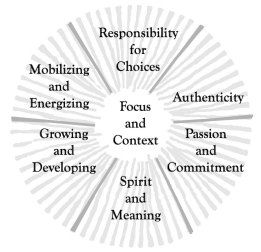 |
 |
|
 |
Timeless Leadership Principles
By Jim Clemmer
While interviewing the legendary Jack Nicklaus, a reporter once remarked,
"Jack, you have had a spectacular career. Your name is synonymous
with the game of golf. You really know your way around the course. What
is your secret?" Nicklaus replied, "The holes are numbered!"
If only leadership were so easy. (Given the sad state of my game, I'm
the last person who should use "easy" and "golf" in
the same sentence!) Of course, there are no handily numbered steps that
we can follow in developing our leadership. But after decades of studying
leadership—of writing and speaking about it, trying to practise
it, and coaching thousands of managers in it—I am convinced that
there are timeless leadership principles which we can all use to be more
effective in our personal and professional lives.
In the late 1990s, I published my fourth leadership book, Growing the
Distance: Timeless Principles for Personal, Career and Family Success,
now approaching 100,000 copies in print. The response to the book and
its leadership principles was so strong that I continued to develop them.
That led to my newest—just published—companion book, The Leader's
Digest: Timeless Principles for Team and Organization Success.
A recent search on Amazon.com revealed that there are over 10,000 leadership
books in print! There are as many different interpretations of "leadership"
as there are people using the term. The result is a confusing multitude
of leadership grids, charts, formulas, jargon, fads, and buzzwords, with
new ones popping up every week. An occupational hazard of this business
is that we chase after what's new rather than what works. We look for
fashionable rather than enduring principles.
Most of my audiences are very experienced middle to senior managers in
medium to large organizations who don't need to be educated or informed
as much as they need to reminded, inspired, reinforced, or shown different
ways of applying familiar leadership principles.
Historians, anthropologists and scholars of classic literature tell us
that there are really quite a small number of recurring stories in the
entire history of humanity. Our books and movies provide us with endless
variations on the basic stories of the human condition, and the same themes
keep showing up in the stories of people and cultures thousands of years
or miles apart. Enduring leadership principles are just as timeless. They
aren't new. It is the timelessness of these principles that prove their
value.
Leadership needs management to fly
Both management and leadership are needed to make teams and organizations
successful. In building our speaking, consulting, and training businesses,
we also need a good balance of both management and leadership. Trying
to decide which is most important is like trying to decide whether the
right or left wing is more important to an airplane's flight. I'll take
both, please!
A classic problem often comes up among entrepreneurial start-up companies
with strong vision, passion and energy (leadership), and good technological
or technical skills: their poor management discipline or lack of systems
and processes lead to errors, poor service quality, and frustration for
customers and people in the organization. In building our businesses,
we need to couple our passion and creative spirit with disciplined processes
and business management.
The leadership wheel
 |
The most common weakness, however, is lack of leadership. Growing our
leadership is a dynamic process. It begins at the centre of our being
and develops in multiple directions. I use the "hub and spokes"
model to depict the timeless leadership principles. (Both Growing the
Distance and The Leader's Digest are built around it.)
Each part of the wheel corresponds to an area of leadership. At the hub
of the wheel, we have the vision, values and purpose on which leaders
effectively focus themselves and their teams or organizations (Focus and
Context). Leaders also take initiative and do what needs to be done rather
then waiting for someone else to do something (Responsibility for Choices).
Leaders are authentic and lead by visible example, fostering openness
and continuous feedback (Authenticity). Leaders are passionate and build
strong commitment through involvement and ownership (Passion and Commitment).
Leaders lead with heart and rouse team or organizational spirit (Spirit
and Meaning). Leaders help people grow through strong coaching and continuous
development (Growing and Developing). Finally, leaders energize people
by building strong teams, inspiring and serving (Mobilizing and Energizing).
The leadership wheel model provides a metaphor for situations we face
at personal, team or organizational levels. For example, just as a wheel's
weight-bearing ability depends upon the strength of its hub, so does the
strength of our hub determine the weight of the performance and change
issues that we are able to carry.
The wheel also represents the circular nature of leadership: there is
no beginning or end. All the supporting leadership principles around the
outside of the Leadership Wheel are interdependent and interconnected.
If we, our team or our organization develop these leadership skills, the
wheel is well rounded. If we are deficient in one or more of these skills,
the ride might be a little bumpy.
A key part of our continuous leadership quest is finding the approaches
that fit our individual values, personality and style. No one leadership
size fits all. It is like trying to find a path in a field of newly fallen
snow. Once we walk across the field, we have discovered our path.
| Excerpted from Jim's bestseller, The
Leader's Digest: Timeless Principles for Team and Organization Success.
View the book's unique format and content, Introduction and Chapter
One, and feedback at www.theleadersdigest.com.
This book is a companion book to Growing
the Distance: Timeless Principles for Personal, Career, and Family
Success. Jim Clemmer is an internationally acclaimed keynote speaker,
workshop/retreat leader, and management team developer on leadership,
change, customer focus, culture, teams, and personal growth. His web
site is www.clemmer.net. |

top of page |
 |
